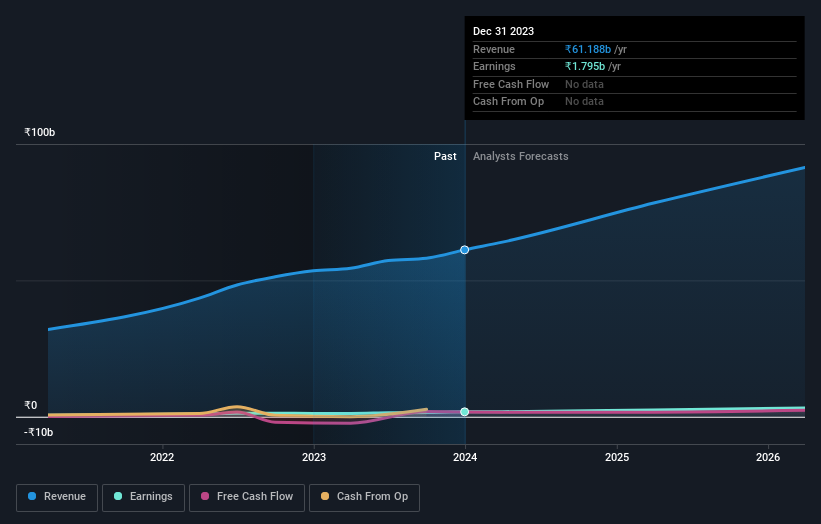- India
- /
- Specialty Stores
- /
- NSEI:EMIL
Recent 11% pullback would hurt Electronics Mart India Limited (NSE:EMIL) insiders

Key Insights
- Significant insider control over Electronics Mart India implies vested interests in company growth
- The top 2 shareholders own 73% of the company
- Institutions own 17% of Electronics Mart India
Every investor in Electronics Mart India Limited (NSE:EMIL) should be aware of the most powerful shareholder groups. And the group that holds the biggest piece of the pie are individual insiders with 73% ownership. Put another way, the group faces the maximum upside potential (or downside risk).
And last week, insiders endured the biggest losses as the stock fell by 11%.
Let's take a closer look to see what the different types of shareholders can tell us about Electronics Mart India.
Check out our latest analysis for Electronics Mart India

What Does The Institutional Ownership Tell Us About Electronics Mart India?
Many institutions measure their performance against an index that approximates the local market. So they usually pay more attention to companies that are included in major indices.
As you can see, institutional investors have a fair amount of stake in Electronics Mart India. This can indicate that the company has a certain degree of credibility in the investment community. However, it is best to be wary of relying on the supposed validation that comes with institutional investors. They too, get it wrong sometimes. It is not uncommon to see a big share price drop if two large institutional investors try to sell out of a stock at the same time. So it is worth checking the past earnings trajectory of Electronics Mart India, (below). Of course, keep in mind that there are other factors to consider, too.

We note that hedge funds don't have a meaningful investment in Electronics Mart India. The company's largest shareholder is Pavan Bajaj, with ownership of 37%. For context, the second largest shareholder holds about 36% of the shares outstanding, followed by an ownership of 5.3% by the third-largest shareholder. Karan Bajaj, who is the second-largest shareholder, also happens to hold the title of Chief Executive Officer.
After doing some more digging, we found that the top 2 shareholders collectively control more than half of the company's shares, implying that they have considerable power to influence the company's decisions.
Researching institutional ownership is a good way to gauge and filter a stock's expected performance. The same can be achieved by studying analyst sentiments. There is some analyst coverage of the stock, but it could still become more well known, with time.
Insider Ownership Of Electronics Mart India
The definition of company insiders can be subjective and does vary between jurisdictions. Our data reflects individual insiders, capturing board members at the very least. Company management run the business, but the CEO will answer to the board, even if he or she is a member of it.
Most consider insider ownership a positive because it can indicate the board is well aligned with other shareholders. However, on some occasions too much power is concentrated within this group.
It seems that insiders own more than half the Electronics Mart India Limited stock. This gives them a lot of power. Given it has a market cap of ₹70b, that means they have ₹51b worth of shares. Most would argue this is a positive, showing strong alignment with shareholders. You can click here to see if those insiders have been buying or selling.
General Public Ownership
The general public-- including retail investors -- own 10% stake in the company, and hence can't easily be ignored. This size of ownership, while considerable, may not be enough to change company policy if the decision is not in sync with other large shareholders.
Next Steps:
It's always worth thinking about the different groups who own shares in a company. But to understand Electronics Mart India better, we need to consider many other factors. For instance, we've identified 1 warning sign for Electronics Mart India that you should be aware of.
If you would prefer discover what analysts are predicting in terms of future growth, do not miss this free report on analyst forecasts.
NB: Figures in this article are calculated using data from the last twelve months, which refer to the 12-month period ending on the last date of the month the financial statement is dated. This may not be consistent with full year annual report figures.
Valuation is complex, but we're here to simplify it.
Discover if Electronics Mart India might be undervalued or overvalued with our detailed analysis, featuring fair value estimates, potential risks, dividends, insider trades, and its financial condition.
Access Free AnalysisHave feedback on this article? Concerned about the content? Get in touch with us directly. Alternatively, email editorial-team (at) simplywallst.com.
This article by Simply Wall St is general in nature. We provide commentary based on historical data and analyst forecasts only using an unbiased methodology and our articles are not intended to be financial advice. It does not constitute a recommendation to buy or sell any stock, and does not take account of your objectives, or your financial situation. We aim to bring you long-term focused analysis driven by fundamental data. Note that our analysis may not factor in the latest price-sensitive company announcements or qualitative material. Simply Wall St has no position in any stocks mentioned.
About NSEI:EMIL
Electronics Mart India
Engages in the sale of consumer electronics and durable products in India.
Solid track record and good value.


